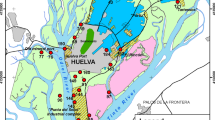Abstract
The aim of this study was to utilize pharmacokinetic techniques to assess the bioavailability of sandy or clay soil-adsorbed naphthalene vs chemical alone following dermal treatment of male rats. Animals were exposed to 43 μg total of 14C-naphthalene (pure or adsorbed to one of two soils) introduced into a shallow glass cap covering a 13-cm2 area on the skin of each rat. While both soils delayed the time to reach maximum plasma concentration of radioactivity and significantly increased the half-life of plasma absorption, only sandy soil significantly decreased the peak plasma concentration of radioactivity versus the pure compound. Within 12 h after dermal application, approximately 50% of the naphthalene dose was excreted in the urine of the pure and clay soil-adsorbed groups. However, when naphthalene was adsorbed to sandy soil, the percentages of the initial dose excreted in the urine collected between 0–12 h and 12–24 h were nearly equal (33–39%). Furthermore, sandy soil adsorption shifted the secondary excretion route from expired air to feces and significantly lowered the amount of radioactivity in expired air relative to naphthalene alone. In the presence of sandy soil, a significantly larger amount of radioactivity washed off of the skin application sites. In all groups the predominant urinary metabolites determined by high performance liquid chromatography were 2,7- and 1,2-dihydroxynaphthalenes.
Similar content being viewed by others
References
ATSDR (1990) Toxicological profile for naphthalene and 2-methylnaphthalene, TP-90–18, Agency for Toxic Substances and Disease Registry, U.S. Department of Health and Human Services, Public Health Service, Atlanta, GA
Buckpitt AR, Bahnson LS, Franklin RB (1984) Hepatic and pulmonary microsomal metabolism of naphthalene to glutathione adducts: Factors affecting the relative rates of conjugate formation. J Pharmacol Exp Ther 231:291–300
Chu I, Villeneuve DC, Côté M, Valli VE, Otson R (1988) Dermal toxicity of a medium-boiling (154–378°C) coal liquefaction product in the rat—Part 1. J Toxicol Environ Health 23:193–206
CLPSD, Contract laboratory program statistical database (1988) Viar and Co, Management Services Division, Alexandria, VA
Corner EDS, Young L (1954) Biochemical studies of toxic agents, 7. The metabolism of naphthalene in animals of different species. Biochem J 58:647–655
Daniel PM, Pratt OE, Pritchard MML (1967) Metabolism of carcinogenic hydrocarbons in rats. Nature (London) 215:1142–1146
Dawson JP, Thayer WW, Desforges JF (1958) Acute hemolytic anemia in the newborn infant due to naphthalene poisoning: Report of two cases with investigations into the mechanism of the disease. Blood 13:1113–1125
Gibaldi M, Perrier D (1975) Pharmacokinetics. Marcel Dekker, NY
Grantham PH, Ba-Giao N, Mohan LC, Benjamin T, Roller PP, Weisburger EK (1976) The metabolism of 6-amino chrysene in the rat. Eur J Cancer 12:227–235
Horning MG, Stillwell WG, Griffin GW, Tsang W-S (1980) Epoxide intermediates in the metabolism of naphthalene by the rat. Drug Metab Disp 8:404–413
Iqbar ZM, Yoshida A, Epstein SS (1979) Uptake and excretion of benzo(a)pyrene and its metabolites by the rat pancreas. Drug Metab Disp 7:44–48
Jeffay H, Alvarez J (1961) Liquid scintillation counting of carbon-14; Use of ethanolamine-ethylene glycol monomethyl ether-toluene. Anal Chem 33:612–615
Mackell JV, Rieders F, Brieger H, Bauer EL (1951) Acute hemolytic anemia due to ingestion of mothballs. Pediatrics 7:722–728
National Cooperative Soil Survey: Official series description-Keyport series (1972) and Atsion series (1977) prepared by the United States Department of Agriculture—Soil Conservation Service, Washington, DC
Ng KME, Chu I, Bronaugh RL, Franklin CA, Somers DA (1992) Percutaneous absorption and metabolism of pyrene, benzo(a)pyrene, and di(2-ethylhexyl)phthalates: Comparison of in vitro and in vivo results in the hairless guinea pig. Toxicol Appl Pharmacol 115:216–223
NRC, National Research Council (1991) Appendix 3A-Frequency of substances reported at final and proposed NPL sites. In: Environmental epidemiology, Vol 1, Public health and hazardous wastes, National Academy Press, Washington, DC, pp 144–146
Odencrantz JE, Farr JM, Robinson CE (1992) Transport model parameter sensitivity for soil cleanup level determinations using SESOIL and AT/123D in the context of the California leaking underground fuel tank field manual. J Soil Contam 1:159–182
Schafer WB (1951) Acute hemolytic anemia related to naphthalene. Pediatrics 7:172–174
Skowronski GA, Turkall RM, Abdel-Rahman MS (1988) Soil adsorption alters bioavailability of benzene in dermally exposed male rats. Am Ind Hyg Assoc J 49:506–511
Skowronski GA, Turkall RM, Abdel-Rahman MS (1989) Effects of soil on percutaneous absorption of toluene in male rats. J Toxicol Environ Health 26:373–384
Skowronski GA, Turkall RM, Kadry AM, Abdel-Rahman MS (1990). Effects of soil on the dermal bioavailability of m-xylene in male rats. Environ Res 51:182–193
Storm JE, Collier SW, Stewart RF, Bronaugh RL (1990) Metabolism of xenobiotics during percutaneous penetration: Role of absorption rate and cutaneous enzyme activity. Fund Appl Toxicol 15:132–141
Tukey JW (1977) Exploratory data analysis. Addison-Wesley, Reading, MA
Turkall RM, Skowronski GA, Gerges S, Von Hagen S, Abdel-Rahman MS (1988) Soil adsorption alters kinetics and bioavailability of benzene in orally exposed male rats. Arch Environ Contam Toxicol 17:159–164
United States Department of Health, Education, and Welfare, and National Institute of Occupational Safety and Health (USHEW-NIOSH) (1977). Criteria for a recommended standard-occupational exposure to coal tar. Washington, DC
Van Heyningen R, Pirie A (1967) The metabolism of naphthalene and its toxic effect on the eye. Biochem J 102:842–852
Velleman PF, Hoaglin DC (1981) Applications, basics and computing of exploratory data analysis (ABC's of EDA). Duxbury Press, Boston, MA
View Database (June 12, 1989) Agency for Toxic Substances and Disease Registry, Office of External Affairs, Exposure and Disease Registry Branch, Atlanta, GA
Author information
Authors and Affiliations
Rights and permissions
About this article
Cite this article
Turkall, R.M., Skowronski, G.A., Kadry, A.M. et al. A comparative study of the kinetics and bioavailability of pure and soil-adsorbed naphthalene in dermally exposed male rats. Arch. Environ. Contam. Toxicol. 26, 504–509 (1994). https://doi.org/10.1007/BF00214154
Received:
Revised:
Issue Date:
DOI: https://doi.org/10.1007/BF00214154




